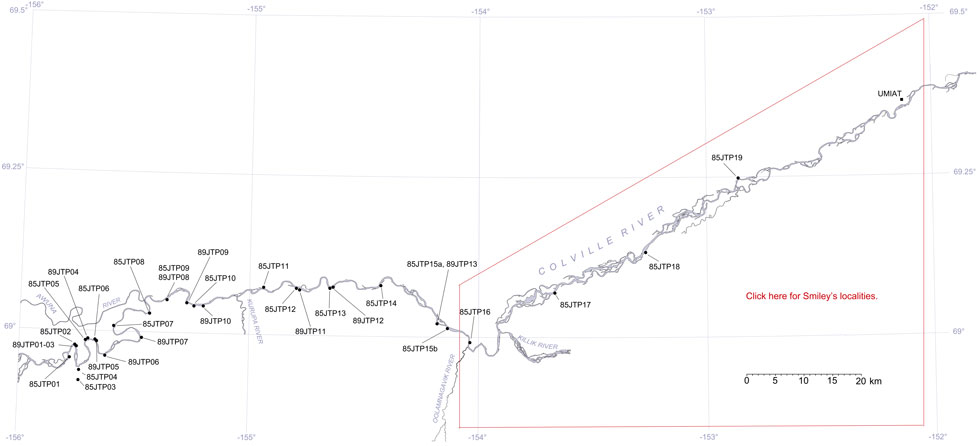Upper Colville River, Alaska
| Upper Colville Fossil Images Unassigned | Fossil Images 85JTP10 |
|---|
This interactive map of part of the Colville River, Northern Alaska, shows the locations of plant fossil collections made by J.T. Parrish and R.A. Spicer in 1985 and 1989. Click on a number for more details on that site. The red outlined area links to another map showing positions of florules (plant fossil assemblages) collected by C.J. Smiley along both the Colville and Chandler Rivers. |

Locality 85JTP10
This locality is mapped as an outcrop of the Upper Killik of the Chandler Formation of Chapman et al. (1964), now regarded as the lower part of the upper third of the Nanushuk Formation of Mull et al. (2003), but the western end of the bluffs with bentonitic mudstones, gray sandstones, yellow-orange and reddish-brown concretionary layers appears more typical of the Niakogon Tongue, or the uppermost part of the Nanushuk Formation.
Conifers and some poorly preserved angiosperms occur in yellow and brown-weathering claystones with a possible platanoid leaf in sandstones. Overall the plant material is sparse at the west end of the section but logs impressions occur with some frequency. Where a section is exposed a very fine sandstone overlies a 'popcorn' weathering bentonitic clay at the base of the cliff. Sitting above the sandstone is a 75 cm thick gray claystone overlain by a 60 cm thick siltstone with ironstone (sideritic) concretions. In turn this is overlain by a 15 cm thick sandstone followed by a 3.25 m thick claystone that becomes bentonitic approximately 10 cm below a 10 cm thick coal. Eroded out sideritic concretions sourced most of the plant material found at this site. The flora consisted of large digitate ginkos associated with Scheffleraephyllum leaves and leaflets. Fossil wood (logs typically 25-35 cm in diameter, sometimes with the bark still preserved) occurs as float. Locally numerous entire-margined cycadophytes, together with conifers such as Podozamites, Cephalotaxopsis intermedia, Sequoia cf. tenuifolia, Pityophyllum and ferns such as Adiantites make up the bulk of the preserved megaflora.
Towards the downstream (eastern) end of the section a lower coal is exposed, below which is is a red/brown sideritic layer with a 'knobbly' upper surface immediately below the coal. This ironstone layer contains roots, woody fragments etc. and overlies a laminated layer with numerous leafy fragments.
 |
Sketch of the 85JTP10 section looking south showing the locations of some of the specimens. Specimen numbers increase downstream (to the left in this sketch). |
Between the locations of 85RAS131 and 85RAS132 (see above) a 2 m thick fine lenticular sandstone is exposed containing fragmented branches, conifer shoots, ginkgos and taxodiaceous cones. Further downstream (approximately 400 m) fallen fine light gray, weathering to red/orange, crossbedded sandstone blocks yield platanoids with poorly organised secondary and tertiary veins, together with ginkgos and conifers, log and branch impressions.
Further downstream still a succession of dark red rooted ironstones originating from covered weathered bentonitic clays contain angiosperms as well as conifers (specimens 85RAS134-138). A further 250 m downstream the wood specimen 85RAS139 was recovered. Platanoids occur in very fine orange-weathering sandstone float blocks associated with the first major sandstone body at the east end of the section. This sandstone has a conglomeratic base and fines up to a fine sand overlain and eroded into by by another sandstone body witrh a conglomeratic base. This conglomerate, interpreted as the base of an infilled river channel, contains some unusually large clasts (fist-sized boulders), logs and is strongly cross-bedded.
